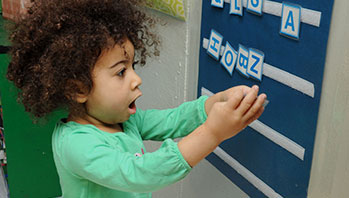- tape strip (1 for each child)
MA Standards:
English Language Arts/Foundational Skills/RF.PK.MA.2.c: Identify the initial sound of a spoken word and, with guidance and support, generate several other words that have the same initial sound.
Head Start Outcomes:
Language Development/Receptive Language: Attends to language during conversations, songs, stories, or other learning experiences.
Literacy Knowledge/Phonological Awareness: Identifies and discriminates between sounds and phonemes in language, such as attention to beginning and ending sounds of words and recognition that different words begin or end with the same sound.
PreK Learning Guidelines:
English Language Arts/Reading and Literature 8: Listen to, identify, and manipulate language sounds to develop auditory discrimination and phonemic awareness.
Learn About Sounds Together: Letter Sound (/e/)

© Commonwealth of Massachusetts, Department of Early Education and Care (Jennifer Waddell photographer). All rights reserved.
ELA Focus Skills: Follow Directions, Phonological Awareness, Speaking and Listening
Line children up side by side. In front of each child place a strip of tape. Tell children that you are going to say some words and you want them to listen for the words that begin with /e/ like in the word engine. Say, When I say a word that begins with /e/ I want you to walk to the other e-e-e-end of your strip of tape and stand on it.
- Have a volunteer demonstrate. Say the word e-e-e-elephant. Have the child walk to the other end of her strip.
- Then continue with other words, such as engine, enter, end as all children listen and walk to the end of their strip.
- You may want to have children take turns offering a word.
Educator Tip: If you have children who have a long /e/ in their names (i.e, Elizabeth, Eve), you may want to explain that the letter “Ee” sometimes makes the sound you hear in elephant, but other times it makes the sound you hear in ear.
Adaptation: For older children, you may want to have them make alliterative sentences out of the /e/ words supplied.
Adaptation: For younger children, you may prefer not to use so many words. Have children identify just a few.
Educator Tip: You may want to use this opportunity to review other letter sounds learned and create alliterative sentences with these letter sounds.
